*** IMPORTANT - I'm retiring my digital files - SVG/PNG/DXF/EPS - and printables from 31st December 2025 ***
*** Please ensure that you have everything you need - files and/or instructions printed off from the website (find them currently in the ARCHIVES section) - by 31st December 2025 as they will not be available after this date ***

What is the Celtic Tree Calendar?
- Home
- Art - Living Archives
- Celtic Tree Art
- Celtic Tree Calendar
Learn about the Celtic Tree Calendar - what it is, how it came about, what it means, and how we can relate to it in our modern lives...
This is part of my Celtic Tree project, learning all about the myth, meaning, symbolism, history, and folklore of all of our favourite trees over a year of drawing and creating art illustrations for each of the thirteen trees in the tree calendar.
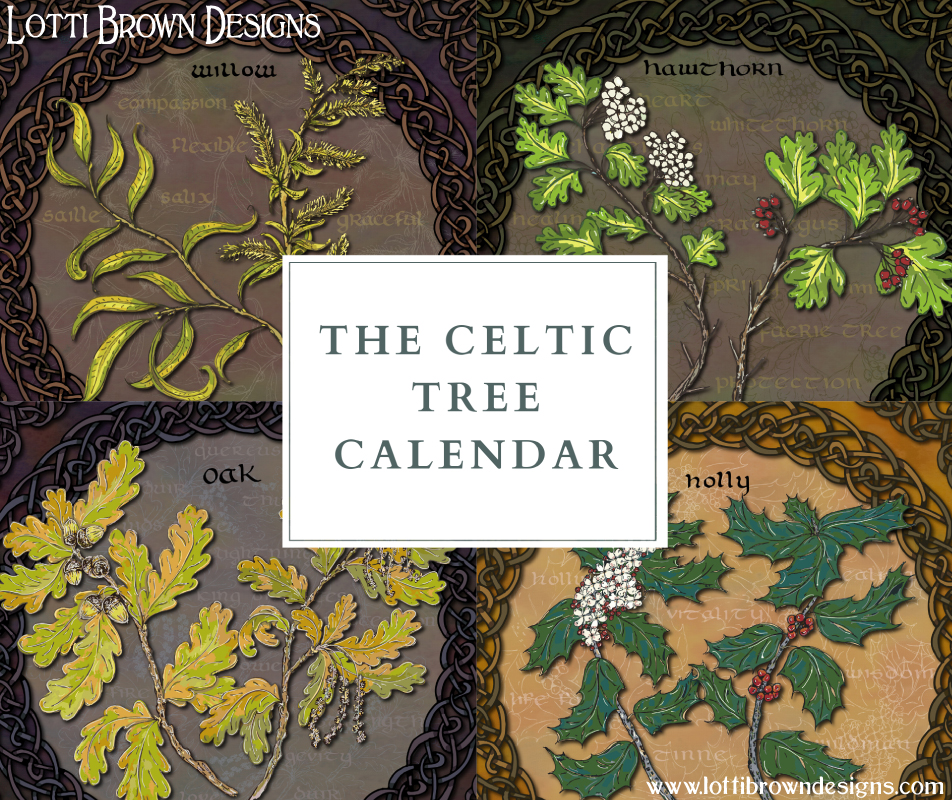 Celtic Tree Calendar art by Lotti Brown
Celtic Tree Calendar art by Lotti BrownWhat is the Celtic Tree Calendar?
It's a calendar idea that allocates a tree to a month (or period of time) similar to the zodiac idea that we’re all familiar with.
The months are actually based around lunar months of 28 days so there are 13 months and 13 corresponding trees in each year.
The Celtic Tree Calendar that’s widely used is based on Robert Graves’ idea of a Celtic Tree Calendar put forward in his book ‘The White Goddess’.
The Celtic Tree Calendar is actually a beautiful idea – focusing our attention on our different trees and appreciating their beauty as well as their natural history and the parts they’ve played in our own social and cultural story…
I love the idea and I’ve based my Celtic Tree Project around the 13 tree months. It’s certainly a wonderful idea and it’s really captured the public imagination. I think it’s a great way for us all to feel more connected with nature…
Celtic tree calendar dates
- December 24th to January 20th – Birch
- January 21st to February 17th – Rowan
- February 18th to March 17th – Ash
- March 18th to April 14th – Alder
- April 15th to May 12th – Willow
- May 13th to June 9th – Hawthorn
- June 10th to July 7th – Oak
- July 8th to August 4th – Holly
- August 5th to September 1st – Hazel
- September 2nd to September 29th – Vine
- September 30th to October 27th – Ivy
- October 28th to November 23rd – Reed
- November 24th to December 23rd - Elder
Although it’s a beautiful and compelling idea, the actual Celtic Tree Calendar is a relatively modern concept and not based in any historical Celtic calendar but does have its origins in a so-called ‘Celtic Tree Alphabet’.
Let’s see if we can decipher what’s going on…
Where does the Celtic Tree Calendar come from?
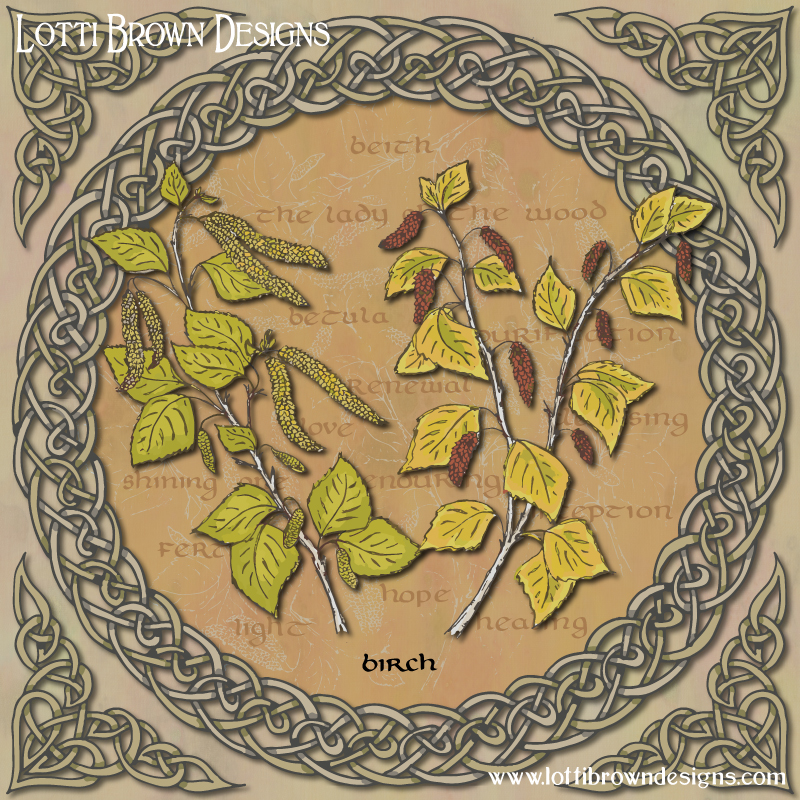 Celtic birch tree art by Lotti Brown
Celtic birch tree art by Lotti BrownNovelist and poet Robert graves wrote his study on Celtic mythology ‘The White Goddess’ in 1946 and it was published in 1948.
In it, Graves took the idea of the early-medieval Irish ogham alphabet, which was believed to be based on trees, and re-arranged it to suit his idea, naming 13 months after trees.
The ogham alphabet itself, which looks rather rune-like with branching lines (like trees) dates from the 5th and 6th centuries. It’s a form of lettering that’s nearly always found carved on monumental stones (stones used for personal monuments).
Most of the ogham inscriptions we have are from stones in Ireland and Wales but there are a few stones in Scotland, the Isle of Man, and England as well.
We do have some reference to ogham letters being written on wood, as well as stone, and later writings which help us to decipher these mysterious letters or symbols.
The ogham alphabet is known as the ‘Beith-luis-nin’ – thought to be named after the order of the first couple of letters of the alphabet – so it means the ‘Beith-luis alphabet’.
Interestingly, the ogham letters are generally accepted as being named after trees and shrubs, although, of course, it turns out it’s not so simple as that…
We do have a couple of books that describe the ogham letters and help us to understand them.
- In Lebor Ogaim (‘The Book of Ogams’) known as The Ogam Tract – the earliest copy dates from the late 14th century
- Auraicept na n-Eces (‘The Scholars’ Primer’) – the earliest copy dates from the 12th century with text purporting to be from the mid 7th century written by the scholar Longarad
In The Ogam Tract, the god Ogma/Ogmios is said to have created the ogham lettering system and named all the letters after trees.
The Scholars’ Primer also suggests that the ogham letters are based on trees…
“Now all these are wood names such as are found in the Ogham Book of Woods, and are not derived from men …. Some of these trees are not known today.”
The Scholars’ Primer also gives an explanatory phrase for each letter, called a ‘Briatharogam’.
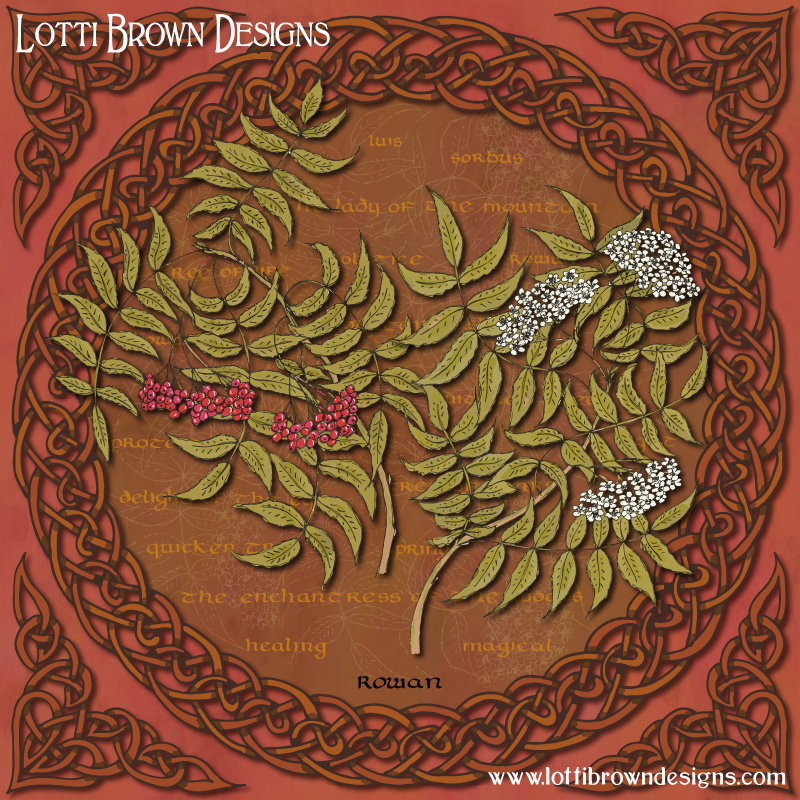 Celtic Rowan art by Lotti Brown
Celtic Rowan art by Lotti BrownWe discover that, actually, only 5 of the 20 primary letters relate directly to known trees:
- Beith – birch
- Fearn – alder
- Saille – willow
- Duir – oak
- Coll – hazel
The other trees suggested there are actually interpretations or ‘glosses’ - explanations which are often contested, and it’s entirely possible that the tree alphabet ogham letters were not named after trees at all.
The Scholars’ Primer itself also suggests (alongside the tree theory in the Ogam Tract) that ogham may have been created along with the Gaelic language by the legendary king of Scythia, Fenius Farsa, who studied the languages of the Tower of Babel and created the Goidelic/Gaelic language with the ‘Beith-luis-nin’ (ogham letters) as the written form of the language and the 25 letters were named after his best scholars.
The Ogam Tract also shows us that other forms of ogham were used and contains lists of:
- Bird-ogam (enogam)
- Colour-ogam (dathogam)
- Dog-ogam (conogam)
- Cow-ogam (bo-ogam)
- Water-ogam (ogam visceach)
- Boy-ogam (macogam)
And many more…!
So it seems that although Graves’ Celtic Tree Calendar does have a basis in the historic ogham, often known as the tree alphabet, the monthly ascribing of trees was his own invention and not the genuinely historical Celtic calendar.
The Historical Celtic Calendar
In fact, we do know something of the original historical Celtic calendar. The original Celtic calendar is known as the Coligny Calendar. It was discovered at Coligny in France and dates from the end of the 2nd century AD but is thought to relate to concepts that may date to around 800BC.
It is a ‘lunisolar’ calendar, which means that it is an attempt to reconcile lunar months with the solar year (which we work our modern calendar to.)
Each month begins with the dark part of the lunar cycle (when the moon is dark in the sky). And the calendar consists of 62 lunar months across 5 solar years – including an extra ‘intercalary’ month every 2-and-a-half years which keeps the whole lunar calendar in sync with the solar year.
Each lunar month started with a dark fortnight of 15 days, relating to the dark part of the lunar cycle – followed by a bright fortnight of 14 or 15 days – so each month was 29 or 30 days long.
In line with each month starting with darkness (and the Celts’ practice of beginning each full day at sunset (doing the dark part of the day first) it is likely that the calendar year began with the dark part of the year, probably around Halloween/Samhain (1st November).
We have the names and order of the months, but we don’t know where they fit with our modern-day calendar – and the names are still open to some interpretation and suggestion as to meaning and position.
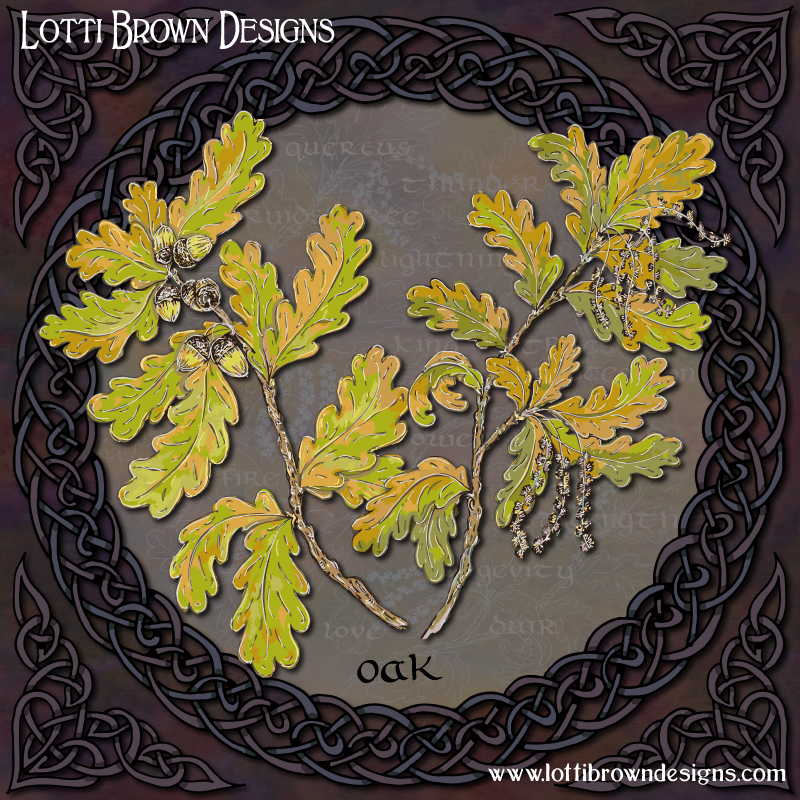 Celtic Oak art by Lotti Brown
Celtic Oak art by Lotti BrownColigny Calendar Months
1) Samonios – 'summer’s month'
2) Dumannios – ('smoke' ? )
3) Riuros – ('stout'/'fat' ? )
4) Anagantio – ('non-travelling' ? )
5) Ogronnios – 'cold month'
6) Qutios - (unknown)
Rantaranos (intercalary month – every 3rd year)
7) Giamonios – 'winter’s month'
8) Semiuisonns - (unknown)
9) Equos - (unknown)
10) Elembiuios – ('deer' ? )
11) Aedrinios – ('fire' or 'heat' ? )
12) Cantlos – ('song' ? )
Our historical Coligny Celtic calendar is truly fascinating in itself – but our own longing for connection with nature does seem to compel us towards the Celtic Tree Calendar – and the idea of living our lives under the auspices of our beautiful trees and shrubs, stalwarts of the natural world…
And for centuries, if not millennia, revered as our healers and protectors, the axis around which our lives turn…
So it seems only natural to use to turn to our tree protectors for comfort and inspiration as we mark the months of our own lives.
That’s what my Celtic Tree Calendar project is about – our historical, spiritual, and mythological relationship with trees…
You can see all my Celtic Tree Calendar artworks on this page....
Tree Meanings, Myths & Symbolism
I'm adding extra sections with a detailed look at the myths, meanings and symbolism for each of the trees across the tree calendar year.
This is a project I did across 2020-21 and published originally on my blog at the time, but had to change website platforms and start again from scratch so I'm adding them again now to my new website, one month at a time across a year...
- December 24th to January 20th – Birch
- January 21st to February 17th – Rowan - read about the myths and meanings of Rowan here...
- February 18th to March 17th – Ash - read about the myths and meanings of Ash here...
- March 18th to April 14th – Alder - read about the myths and meanings of Alder here...
- April 15th to May 12th – Willow - read about the myths and meanings of Willow here...
- May 13th to June 9th – Hawthorn - read about the myths and meanings of Hawthorn here...
- June 10th to July 7th – Oak - read about the myths and meanings of Oak here...
- July 8th to August 4th – Holly - read about the myths and meanings of Holly here...
- August 5th to September 1st – Hazel - read about the myths and meanings of Hazel here...
- September 2nd to September 29th – Vine - read more about the myths and meanings of Vine (Bramble) here...
- September 30th to October 27th – Ivy - read more about the myths and meanings of Ivy here...
- October 28th to November 23rd – Reed - read about the myths and meanings of Reed/Fern here...
- November 24th to December 23rd - Elder - read about the myths and meanings of Elder here...
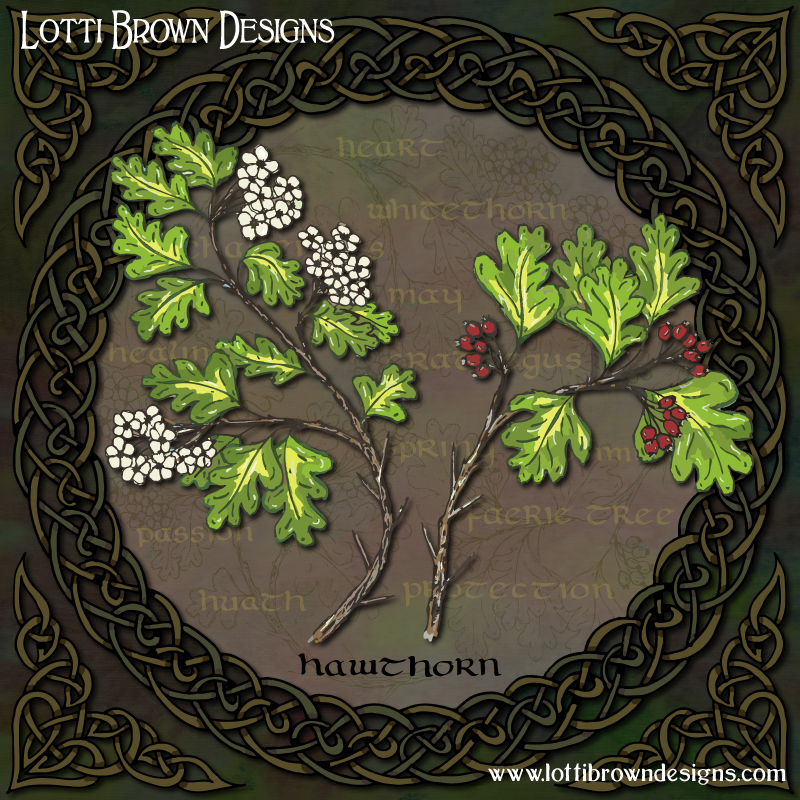 Celtic Hawthorn art by Lotti Brown
Celtic Hawthorn art by Lotti BrownWhere to go next...
Click here to see all my Celtic tree calendar artworks...
I also have other Celtic artworks here and lots of other nature artworks here...
And a hub for all my nature-focused folklore content on this page...
If you like the idea of feeling more connected to nature, you might also like my section about nature journaling, here - it's easy to get into and we like to nature journal 'imperfectly' for enjoyment, well-being and connection to nature, so there's no need to worry about not being able to draw or anything like that! Find out more here...
You might also enjoy a book I read, 'The Oak Papers' all about our relationship with the oak tree.
 Celtic knotwork unisex sweatshirt
Celtic knotwork unisex sweatshirtYou might also like to take a look at my Celtic knotwork designs (see above)- there's fabrics, wallpapers and other products including T-shirts and sweatshirts, cushions, shower curtains, throw blankets, mugs, bags, notebooks and much more - all in lots of different colour options - check it out here!
Explore my current art collections here!
Shall we stay in touch..?
Each month, I share stories from my own nature journal, new art from my studio, and simple seasonal inspiration to help you feel more connected with the turning year...
Recent Articles
-
British Nature Folklore Library: Stories, Seasons & Celtic Tree Wisdom
Dec 01, 25 05:09 AM
Explore British nature folklore, Celtic tree meanings, and seasonal wildlife stories. A growing library of myth, meaning, and hand-drawn inspiration. -
Beautiful Art Inspired by Nature
Dec 01, 25 05:04 AM
Beautiful folksy art inspired by nature from the fields and hedgerows of Yorkshire - colourful birds and wildlife with a nostalgic floral touch... -
Birds and Folklore in Britain: A November Nature Journal
Nov 26, 25 04:32 AM
November birds and berries - fieldfares, redwings, lapwings and snow geese with folklore, meaning and nature journal inspiration.
Follow me:
Share this page:







